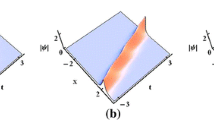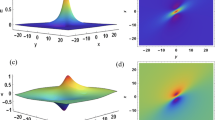Abstract
Under investigation in this paper is a (3+1)-dimensional Yu–Toda–Sasa–Fukuyama equation. Employing the Kadomtsev–Petviashvili hierarchy reduction, we obtain the semi-rational solutions which describe the interactions between the lumps/rogue waves and the parallel line solitons. We find that the phase difference of two solitons determines the waves amplitudes and the forms of the interactions. Asymptotic analysis shows that the solitons keep their shapes before and after the interactions, which means the interactions are elastic. On the x-y and \(z-y\) planes, the lump waves generate in the middle of solitons, while the line rogue waves only raise on the x–z plane. We show the connection with the general form of multi-soliton solutions mathematically, and analyze the interactions through four characteristic lines, which present the shapes and propagation traces of the localized waves. We find that the amplitudes of lumps affect the interaction patterns, as well as the strength and position of soliton. When \(N\ge 3\), interactions among lumps and solitons show more complex phenomena, our analysis summarizes the law of the interaction pattern. The numerical simulations of the nonlinear waves are also given.








Similar content being viewed by others
Data Availability
All data supporting the findings of this study are included in this published article.
References
Gu, C.: Soliton theory and its applications. Springer Science and Business Media (2013)
Blow, K.J., Doran, N.J., Nayar, B.K.: Experimental demonstration of optical soliton switching in an all-fiber nonlinear Sagnac interferometer. Opt. Lett. 14, 754 (1989)
Zhang, S., Zheng, X.: N-soliton solutions and nonlinear dynamics for two generalized Broer-CKaup systems. Nonlinear Dynam. 107, 1179–1193 (2022)
Hu, B.B., Lin, J., Zhang, L.: Dynamic behaviors of soliton solutions for a three-coupled Lakshmanan-Porsezian-Daniel model. Nonlinear Dynam. 107, 2773–2785 (2022)
Manakov, S.V., Zakharov, V.E., Bordag, L.A.: Two-dimensional solitons of the Kadomtsev-Petviashvili equation and their interaction. Phys. Lett. A 63, 205 (1977)
Diorio, J., Cho, Y., Duncan, J.H.: Gravity-capillary lumps generated by a moving pressure source. Phys. Rev. Lett. 103, 214502 (2009)
Kumar, S., Mohan, B., Kumar, R.: Lump, soliton, and interaction solutions to a generalized two-mode higher-order nonlinear evolution equation in plasma physics. Nonlinear Dynam. 110, 693–704 (2022)
Wang, C., Fang, H., Tang, X.: State transition of lump-type waves for the (2+ 1)-dimensional generalized KdV equation. Nonlinear Dynam. 95, 2943–2961 (2019)
Lü, X., Chen, S.J.: Interaction solutions to nonlinear partial differential equations via Hirota bilinear forms: one-lump-multi-stripe and one-lump-multi-soliton types. Nonlinear Dynam. 103, 947–977 (2021)
Rao, J., Chow, K.W., Mihalache, D., He, J.: Completely resonant interaction of lumps and line solitons in the Kadomtsev-Petviashvili I equation. Stud. Appl. Math. 147, 1007–1035 (2021)
Rao, J., Fokas, A.S., He, J.: Doubly localized two-dimensional rogue waves in the Davey-Stewartson I equation. J. Nonlinear Sci. 31, 1–44 (2021)
Fuchssteiner, B., Fokas, A.S.: Symplectic structures, their Baäcklund transformations and hereditary symmetries. Physica D 4, 47–66 (1981)
Yu, S.J., Toda, K., Sasa, N., et al.: N soliton solutions to the Bogoyavlenskii-Schiff equation and a quest for the soliton solution in (3+1) dimensions. J. Phys. A 31, 3337 (1998)
Huang, Q.M., Gao, Y.T.: Bilinear form, bilinear Bäcklund transformation and dynamic features of the soliton solutions for a variable-coefficient (3+1)-dimensional generalized shallow water wave equation. Mod. Phys. Lett. B 31, 1750126 (2017)
Huang, Q.M., Gao, Y.T., Jia, S.L., et al.: Bilinear Bäcklund transformation, soliton and periodic wave solutions for a (3+1)-dimensional variable-coefficient generalized shallow water wave equation. Nonlinear Dynam. 87, 2529–2540 (2017)
Zhao, X., Tian, B., Qu, Q. X., et al.: Kadomtsev-Petviashvili hierarchy reduction, soliton and semi-rational solutions for the (3+1)-dimensional generalized variable-coefficient shallow water wave equation in a fluid. Int. J. Comput. Math. 1-19 (2021)
Chen, W. Q., Guan, Q. F., Jiang, C.F., et al.: Nonautonomous motion study on accelerated and decelerated lump waves for a (3+1)-Dimensional generalized shallow water wave equation with variable coefficients. Complexity 2019, (2019)
Hu, C.C., Tian, B., Qu, Q.X., Yang, D.Y.: The higher-order and multi-lump waves for a (3+1)-dimensional generalized variable-coefficient shallow water wave equation in a fluid. Chinese J, Phys (2021)
Liu, J.G., Zhu, W.H.: Breather wave solutions for the generalized shallow water wave equation with variable coefficients in the atmosphere, rivers, lakes and oceans. Comput. Math. Appl. 78, 848–856 (2019)
Liu, J.G., Zhu, W.H., He, Y., Lei, Z.Q.: Characteristics of lump solutions to a (3+1)-dimensional variable-coefficient generalized shallow water wave equation in oceanography and atmospheric science. Eur. Phys. J. Plus 134, 1–7 (2019)
Yan, Z.Y.: New families of nontravelling wave solutions to a new (3+1)-dimensional potential-YTSF equation. Phys. Lett. A 318, 78–83 (2003)
Zhang, T.X., et al.: Non-travelling wave solutions to a (3+1)-dimensional potential-YTSF equation and a simplified model for reacting mixtures. Chaos, Solitons Fractals 34, 1006–1013 (2007)
Yin, H.M., Tian, B., Chai, J., et al.: Solitons and bilinear Bäcklund transformations for a (3+1)-dimensional Yu-Toda-Sasa-Fukuyama equation in a liquid or lattice. Appl. Math. Lett. 58, 178–183 (2016)
Liu, W.: Rogue waves of the (3+1)-dimensional potential Yu-Toda-Sasa-Fukuyama equation. Rom. Rep. Phys 69, 16 (2017)
Hirota, R.: The direct method in soliton theory. Cambridge Univ. Press, Cambridge (2004)
Hu, B.B., Lin, J., Zhang, L.: On the Riemann-Hilbert problem for the mixed Chen-Lee-Liu derivative nonlinear Schrödinger equation. J. Comput. Appl. Math. 390, 113393 (2021)
Hu, B.B., Lin, J., Zhang, L.: Riemann-Hilbert problem associated with the vector Lakshmanan-Porsezian-Daniel model in the birefringent optical fibers. Math. Meth. Appl. Sci. 45(17), 11545–11561 (2022)
Hu, B.B., Lin, J., Zhang, L.: On the Riemann–Hilbert problem for the integrable three-coupled Hirota system with a \(4\times 4\) matrix Lax pair. Appl. Math. Comput. 428, 127202 (2022)
Hu, B.B., Lin, J., Zhang, L.: The initial-boundary value problems of the new two-component generalized Sasa-Satsuma equation with a \(4\times 4\) matrix Lax pair. Anal. Math. Phys. 12, 109 (2022)
Klein, C., Roidot, K.: Fourth order time-stepping for Kadomtsev-CPetviashvili and Davey-CStewartson equations. SIAM J. Sci. Comput. 33, 3333 (2011)
Ohta, Y., Yang, J.: Rogue waves in the Davey–Stewartson I equation. Phys. Rev. E 86, 036604 (2012)
Ohta, Y., Yang, J.: General high-order rogue waves and their dynamics in the nonlinear Schrödinger equation. Proc. R. Soc. A 468, 1716 (2012)
Ohta, Y., Yang, J.: Dynamics of rogue waves in the Davey–Stewartson II equation. J. Phys. A 46, 105202 (2013)
Mu, G., Qin, Z.: Dynamic patterns of high-order rogue waves for Sasa-Satsuma equation. Nonlinear Anal.: Real World Appl. 31, 179 (2016)
Ohta, Y., Yang, J.: General rogue waves in the focusing and defocusing Ablowitz-Ladik equations. J Phys. A 47, 255201 (2014)
Acknowledgements
This work has been supported by the Fundamental Research Funds for the Central Universities No. BLX201927, Funded by China Postdoctoral Science Foundation under Grant No. 2019M660491 and Funded by the Natural Science Foundation of Hebei Province (Grant No. A2021502003).
Author information
Authors and Affiliations
Corresponding author
Ethics declarations
Conflict of interest
The authors declare that they have no conflict of interest.
Additional information
Publisher's Note
Springer Nature remains neutral with regard to jurisdictional claims in published maps and institutional affiliations.
Appendix A
Appendix A
In this appendix, we will prove that Solutions (5) satisfy Bilinear Equation (3). Via the idea of Refs. [31, 32], we consider the following coefficient transformation
where \(x_i\)’s are the same as the variable coefficient defined in Refs. [31, 32].
We consider the \(\tau \) functions which meet the KP hierarchy [31,32,33,34,35] and set the Grammian determinant
where \(m^{(n)}_{rj}\), \(\varphi ^{(n)}_{i}\) and \(\psi ^{(n)}_{j}\) are the functions of variables x, y, z and t, satisfying the following differential and difference relations

Using the differential formula of determinant
and the expansion formula of bordered determinant
where \(A _ { r j }\) is the \((r,j)-\)cofactor of the matrix \((a _ { r j })\), we can verify the derivative of the Tau Function (A.1) as follows:
Combined with the definition of the bilinear differential operators, we calculate and simplify Bilinear Equation (3) as follows:
By comparing the Jacobian formula of determinant
we can prove \(\tau _{n}\) satisfies Bilinear Equation (3).
We derive the following solutions
where \(\xi _r\)’s and \(\eta _j\)’s are the functions with respect to the variables x, y, z and t, defined as,
with r and j being two integers and \(p_r\)’s, \(q_j\)’s, \(\xi _{0 r}\)’s and \(\eta _{0j}\)’s being the complex constants. Through some calculations, the element \(m_{rj}^{(n)}\) can be written as follows:
where \(\beta _{rj}\)’s are real constants. Setting some conditions
we get that function.
and \(\tau _0\) is a real functions, with “\(*\)” being the complex conjugate. We can verify that \(f(x,y,z,t)=\tau _0\) is a real.
Rights and permissions
Springer Nature or its licensor (e.g. a society or other partner) holds exclusive rights to this article under a publishing agreement with the author(s) or other rightsholder(s); author self-archiving of the accepted manuscript version of this article is solely governed by the terms of such publishing agreement and applicable law.
About this article
Cite this article
Wu, XY., Yuan, YQ. & Du, Z. Resonant interactions between lumps/rogue waves and solitons for the (3+1)-dimensional Yu–Toda–Sasa–Fukuyama equation. Nonlinear Dyn 111, 14395–14408 (2023). https://doi.org/10.1007/s11071-023-08438-2
Received:
Accepted:
Published:
Issue Date:
DOI: https://doi.org/10.1007/s11071-023-08438-2




